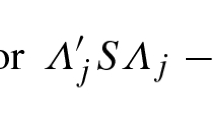Abstract
Nonlinear common factor models with polynomial regression functions, including interaction terms, are fitted by simultaneously estimating the factor loadings and common factor scores, using maximum-likelihood-ratio and ordinary-least-squares methods. A Monte Carlo study gives support to a conjecture about the form of the distribution of the likelihood-ratio criterion.
Similar content being viewed by others
Reference notes
McDonald, R. P. PROTEAN—a comprehensive CD3200/3600 program for non-linear factor analysis. Research Memorandum RM-67-26, 1967, Educational Testing Service, Princeton.
Etezadi-Amoli, J. Nonlinear factor analysis using spline functions. Unpublished M.A. thesis, University of Toronto, 1978.
References
Anderson, T. W. & Rubin, H. Statistical inference in factor analysis.Proceedings of the Third Berkeley Symposium on Mathematical Statistics and Probability, 1956,5, 111–150.
Buse, A. & Lim, L., Cubic spline as a special case of restricted least squares.Journal of the American Statistical Association, 1977,72, 64–68.
Carroll, J. D. Polynomial factor analysis. Proceedings of the 77th Annual Convention of the American Psychological Association, 1969,4, 103–104.
Fletcher, R. & Reeves, C. M. Function minimization by conjugate gradients.Computer Journal, 1964,7, 149–154.
Gnanadesikan, R. & Wilk, M. B. Data analytic methods in multivariate statistical analysis. In P. R. Krishnaiah (Ed.)Multivariate Analysis: II. New York, Academic Press, 1969.
Guttman, L. The determinacy of factor score matrices with implications for five other basic problems of common factor theory.British Journal of Statistical Psychology, 1955,8, 65–82.
Jöreskog, K. G. & Sörbom, D. EFAP-II,Exploratory Factor Analysis Program. Uppsala, Sweden: Department of Statistics, 1978.
Kestelman, H. The fundamental equation of factor analysis.British Journal of Psychology, Statistical Section, 1952,5, 1–6.
Kruskal, J. B. & Shepard, R. N. A nonmetric variety of linear factor analysis.Psychometrika, 1974,39, 123–157.
Lawley, D. N. Further investigations in factor estimation.Proceedings of the Royal Society, Edinburgh, 1942,62, 176–185.
McDonald, R. P. A general approach to nonlinear factor analysis.Psychometrika, 1962,27, 397–415.
McDonald, R. P. Difficulty factors and nonlinear factor analysis.British Journal of Mathematical and Statistical Psychology, 1965,18, 11–23.
McDonald, R. P. Nonlinear factor analysis.Psychometric Monograph No. 15, 1967a.
McDonald, R. P. Numerical methods for polynomial models in nonlinear factor analysis.Psychometrika, 1967b,32, 77–112.
McDonald, R. P. Factor interaction in nonlinear factor analysis.British Journal of Mathematical and Statistical Psychology, 1967c,20, 205–215.
McDonald, R. P. The simultaneous estimation of factor loadings and scores.British Journal of Mathematical and Statistical Psychology, 1979,32, 212–228.
McDonald, R. P. Exploratory and confirmatory nonlinear factor analysis. In H. Wainer & S. Messick (Eds.) Festschrift for F. M. Lord, Hillside, N.J.: Erlbaum,in press.
McDonald, R. P. & Burr, E. J. A comparison of four methods of constructing factor scores.Psychometrika, 1967,32, 381–401.
McDonald, R. P. & Swaminathan, H. A simple matrix calculus with applications to multivariate analysis.General Systems. 1973,18, 37–54.
Neyman, J. & Scott, Elizabeth L. Consistent estimates based on partially consistent observations.Econometrika, 1948,16, 1–32.
Powell, M. J. D. Restarting procedure for the conjugate gradient method.Mathematical Programming, 1975,12, 241–254.
Schuell, H., Jenkins, J. J. & Carroll, J. B. A factor analysis of the Minnesota Test for differential diagnosis of aphasia.Journal of Speech and Hearing Research, 1962,5, 349–369.
Author information
Authors and Affiliations
Additional information
The research reported in this paper was partly supported by Natural Sciences and Engineering Research Grant No. A6346.
Rights and permissions
About this article
Cite this article
Etezadi-Amoli, J., McDonald, R.P. A second generation nonlinear factor analysis. Psychometrika 48, 315–342 (1983). https://doi.org/10.1007/BF02293678
Received:
Revised:
Issue Date:
DOI: https://doi.org/10.1007/BF02293678




